The most spine-tingling structural scares since last Halloween


Large-scale construction projects are almost always tricky, but when the possibility of a structural flaw or defect enters the picture, contractors can face a downright scary situation.
These projects have presented owners and contractors with some particularly spine-tingling predicaments.
The Millennium Tower, San Francisco
The Millennium Tower luxury residential high-rise opened in 2009 but has been sinking steadily, up to as much as 18 inches according to recent estimates, and has been leaning ever so slightly since. It took a citizen complaint call to launch an investigation into the building’s structural integrity, and, so far, the results have been a mixed bag for the skyscraper that had not been anchored into bedrock during initial groundwork.
A July 2017 engineers’ report indicated that the building, despite its troubling shift, could most likely withstand a major earthquake. However, the authors also noted that the structure, which they predicted would sink an inch per year, should be monitored and reevaluated if the building met their expectations for further movement.
But a subsequent NBC Bay Area investigation revealed that a 2016 assessment given to Millennium residents failed to include a different consulting firm’s conclusion that the building’s movement had created gaps between the structure and curtain wall, creating a potential path for fire and smoke. Soon after this was revealed, the city issued building owners a safety violation citation and ordered them to either provide a third-party opinion stating that there was no risk caused by the state of the curtain wall or to just fix the problem.
The only serious proposal for a fix, however, is a $500 million plan to drill pilings into the bedrock on one side of the building, wait for the other side to sink until the tower is level and then install the rest of the pilings. That strategy is in limbo and currently unfunded.
Salesforce Transit Center, San Francisco
Next door to the Millennium Tower is another troubled project, the $2.2 billion Salesforce Transit Center, also known as the Transbay Transit Center, which opened in August. The new transportation hub currently serves only buses, but the plan is to bring rail service there as well, including a stop for the California bullet train.
But in late September, transit center workers discovered a fissure in one of the structure’s steel beams. The center and its public rooftop park were temporarily shut down for further inspections, and one more cracked beam was found in the same area as the first.

Commuter bus traffic was diverted to the old transit center, adjacent roads were blocked off and a four-level shoring system was installed to ensure public safety and to allow a testing agency to take samples of the damaged beams. Public officials have questioned the Transbay Joint Powers Authority’s management and financial capabilities — most recently at a meeting during which city officials voted to temporarily withhold from the authority almost $10 million necessary to start planning for rail service — so the samples will be sent out of state for analysis. The authority expects to have the results by mid-November.
The authority maintains that the project is still under warranty by general contractor Webcor/Obayashi, which recently sued the authority for $150 million for breach of contract. The joint venture alleges that the authority was the source of delays and cost overruns on the project.
Hong Kong-Zhuhai-Macao Bridge, China
Australian contractor Leighton Holdings and the designers of the longest sea crossing in the world, the $18 billion, four-mile bridge and tunnel system connecting the three Chinese regions, might have overlooked the possibility that the four artificial islands built along the bridge’s path could be susceptible to flooding. A $1.1 billion immigration facility on one of those islands has reportedly suffered water intrusion issues, compounded by the fact that designers placed the building’s power supply in the basement.
There has already been one video to emerge showing smoke coming from a flooded switch room, leading experts to warn that workers could face life-threatening dangers unless the equipment is relocated.
Government officials said there are no design flaws and that the equipment in the switch room in question has been replaced and leaks fixed.

Sha Tin-Central Link, Hong Kong
The $12 billion Sha Tin-Central Link rail project in Hong Kong, another Leighton undertaking, is as scary as they come.
Despite Leighton’s protests to the contrary, investigators discovered that 25% of the steel bars used in the construction of the rapid-transit system through their June inspection had been shortened but made to appear as though a complete bar was used. Investigators determined that 5,000 bars were altered in this way.
Rail company MTR filed a complaint with the Hong Kong Police, and rail experts say that the faulty installation could cause safety issues in the years to come.

Silver Line Metro, Washington DC
Publicly funded transportation projects are supposed to be designed for passenger safety and often decades of useful life, which is why contractors and vendors must be sure their products and services provide taxpayers with maximum value. But that doesn’t appear to be the case with the concrete panels that Pennsylvania-based Universal Concrete Products Corp. furnished for the $2.7 billion second phase of the $5.8 billion Silver Line Metro project in Washington D.C.

The Metropolitan Washington Airports Authority, the agency in charge of the project, and contracting team Capitol Rail Constructors found 1,750 defective concrete panels used for station construction. The air content in the panels should have been between 4.5% and 7.5% in order to avoid freeze-thaw ruptures, but the air content in Universal’s panels was allegedly less than 4%.
Fortunately, experts say that the defective panels don’t pose a safety threat, but, unfortunately, Capitol Rail and Universal will have to pay for the application of special coating every 10 years to help preserve the life of station walls.
The U.S. Department of Justice and the Commonwealth of Virginia took legal action against Universal, alleging that the company and a few ex-employees falsified records to make it appear as if the panels met the project’s specifications.
This article was originally written by Kim Slowey and appeared here.


Comment (0)